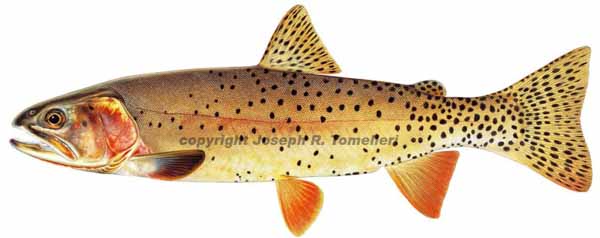Brown Trout
Salmo Trutta
Also known as: German Brown Trout; Brownie; Loch Leven Trout; Saibling; European Brown Trout; Von Behr Trout; English Trout
Brown trout evolved from salmonids in Eurasia and North Africa and are considered native in most of Europe. The U.S. Fish Commission and other agencies introduced the fish to Michigan and New York State starting in 1883.
Brown trout range in color from olive to brown with dark brown or red spots. Their undersides and jaw are white to pearl and they typically grow 7 to 14 inches long, but can grow to as large as 21 inches. Normal weight for the fish is 1 to 2 pounds, but Brown Trout over 10 pounds are fairly common in Feathered Hook waters (think Spring Creek Meadows).
This cagy trout species can live and grow in warmer waters than many North American trout species and prefers rocks, deep pools, overhangs and logs. A fast growing predator, the brown trout feeds on a variety of prey, primarily insects, crayfish and other fish, but larger fish occasionally feast on salamanders, frogs and small mammals. Hooking a big brown on a mouse pattern is something you will never forget.
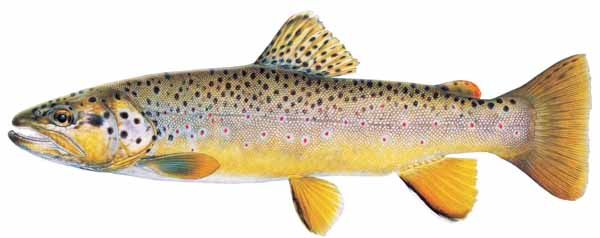
Bonneville Cutthroat Trout
Oncorhynchus clarki Utah
Also known as Bear Lake Cutthroat
Scientists think the Bonneville cutthroat trout evolved as a distinct subspecies during the Pleistocene in Lake Bonneville—a Lake Michigan-sized, 1,000-foot-deep body of water that once straddled the border of Idaho and Utah. About 14,500 years ago a series of floods broke through a natural dam at what is today Red Rock Pass in Idaho. The lake dried up and the Bonneville cutthroat became confined to streams in isolated river drainages of the Bonneville Basin.
In the early 1970’s, researchers feared that over-harvest, hybridization, competition with non-native species, and habitat loss caused the extinction of the fish. But by 1978, genetically pure populations were found and the subspecies has since recovered.
Like all cutthroat trout, the Bonneville cutthroat has a distinctive orange slash—the cut—along its throat. The trout’s coloration is less vivid compared to other cutthroat species and it has large, more evenly distributed spots.
Bonneville cutthroat are found in small, cold, swift running streams. They require clean cool, well oxygenated water, naturally fluctuating flows, low levels of fine sediment in channel bottoms, well-distributed pools, stable stream banks and abundant stream cover. Cutthroat trout favor stoneflies, mayflies and caddisflies during the summer.
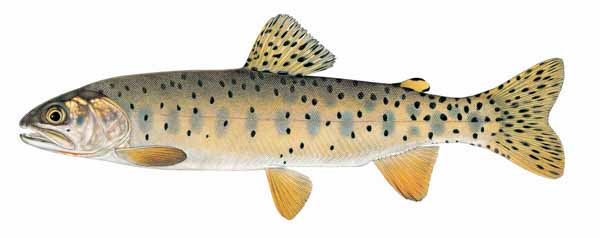
Rainbow Trout
Oncorhynchus Mykiss
Also known as: Bow; Redsides; Steelhead; Red-band Trout; Rainbow; Silver Trout; Steelhead; Kamloops
Rainbow trout are native to states along the west coast of the United States from Alaska to Southern California, as well as Idaho and Nevada. However, the species has been introduced world-wide as a game fish due to its feisty reputation, delicious taste and ability to thrive in hatcheries.
Despite the rainbow trout’s wide distribution and popularity, the U.S. Fish and Wildlife Service has placed several populations of steelhead (sea-run rainbow trout) under Endangered Species Act protection. The primary threats to the species are pollution, habitat loss and dams. Rainbow trout require clear, clean water and the ability to migrate upstream and downstream in order to complete their lifecycles. Rainbow trout are also considered a non-native pest species due to their ability to hybridize and compete with other trout species such as cutthroat trout.
While rainbow trout typically top out at 20 to 30 inches long and eight pounds, some fish grow as long as four feet and 53 pounds. While their markings vary widely depending on habitat and spawning conditions, rainbow trout typically have blue-green or yellow-green backs with a pink streak along their sides for which they are named. They usually have white bellies and small black spots on their fins and tails.
Stream-bound rainbow trout prefer cool, clear water with gravel bottoms, minimal sediment, riffles and pools. They seek refuge behind logs and boulders, or under riparian vegetation. Rainbow trout eat mayflies, stoneflies and caddisflies as well as worms, crayfish, plankton, snails, leeches, grasshoppers, ants and beetles.
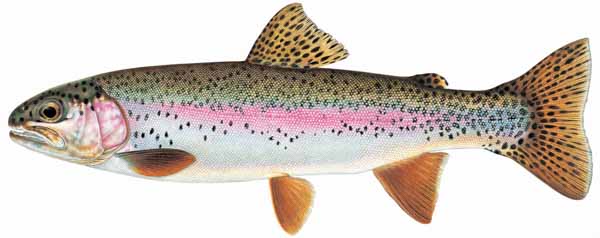
Snake River Cutthroat Trout
Oncorhynchus clarkii ssp
Also known as the fine-spotted cutthroat
The Snake River cutthroat trout is native to the Snake River and its tributaries between Jackson Lake and the Palisades Reservoir. The fish evolved as a morphologically distinct subspecies during the warming and drying of its range during the past 10,000 years when it became isolated to the Snake River Basin from other cutthroat populations.
Fisheries biologists consider the Snake River cutthroat to be the most adaptable subspecies of cutthroat trout and have stocked the fish widely outside of its native range. Because of its importance as a sport fish, the Snake River cutthroat has received considerable attention from biologists, through it remains susceptible to threats such as pollution, habitat loss and hybridization.
The Snake River cutthroat is brownish yellow with silver, green or bronze tints and is covered from head to tail with fine spots except on its belly, which is white. The fish has the same characteristic red or orange slash under its lower jaw as other cutthroat trout.
The Snake River cutthroat prefers large rivers, but readily survives in streams and lakes. Smaller cutthroat eat plankton and aquatic insects, while larger fish also feed on smaller fish and crayfish.
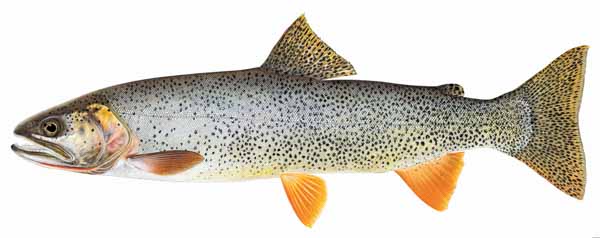
Brook Trout
Salvelinus Fontinali
Also known as: Squaretail; Brookie; Speckled Trout; Mountain Trout; Spotted Trout; Speckled Charr; Native Trout
Brook trout evolved in meltwater from receding glaciers and are native to Atlantic costal areas from Maine to Georgia, the Hudson Bay basin, northeastern Canada, much of the Great Lakes basin, and portions of the upper Mississippi drainage. Humans starting introducing brook trout to the west starting about 1850, and wildlife agencies made more significant efforts to stock the fish outside of its native range around the early 1900s.
On their backs, brook trout vary in color from olive to blue-gray to black with wormlike markings. Their bellies are white or silver with red spots on their sides, and their fins are reddish orange with white front edges.
Brook trout adapt easily to wide range of conditions and temperature extremes, including small spring-fed streams. In streams, they prefer gravel and cobble where they stake out a small home territory. They prefer moderate currents and lots of shade. Their diet includes zooplankton, crustaceans, worms, other fish and small insects.
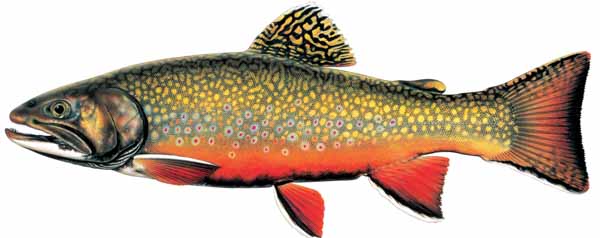
Colorado River Cutthroat Trout
Oncorhynchus clarki pleuriticus
Colorado River cutthroat trout likely evolved about 1 million years ago after an ancestral species spread from the Upper Snake to the Upper Green and eventually into the Colorado River Basin.
Historically, the fish ranged from Colorado, southern Wyoming and eastern Utah to northwestern New Mexico and Northeastern Arizona, but habitat loss and competition from non-native species have significantly reduced the population. Now, Colorado River cutthroat are considered physically isolated and exist at low densities in less than 5 percent of their native range. A number of federal and state agencies consider the fish threatened or sensitive. The fish has been petitioned for Endangered Species Act protection several times, but never afforded federal protection.
The Colorado River cutthroat is more colorful than other subspecies of cutthroats, with a deep red slash under its jaw and a brown to olive colored back with black spots. The belly is typically pale to white yellow for females and orange to bright red for males.
Colorado River cutthroat prefer relatively steep rivers and streams with cold water and lots of cover, and they generally prefer pools to riffles in the summer. Some populations also exist in high mountain lakes. They eat insects and, more rarely, fish and other small vertebrates.
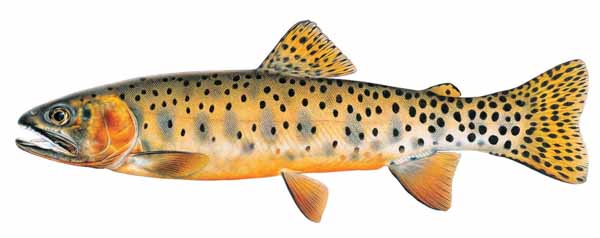
Westslope Cutthroat Trout
Oncorhynchus clarki lewisi
Also known as the black-spotted trout or the redthroated trout
As its scientific name may suggest, historians think explorers on the Lewis and Clark expedition feasted on westslope cutthroat trout during their trek across Montana in the early 1800s. The fish is native to Montana, Idaho, Canada and parts of Wyoming west of the Continental Divide as well as the Missouri River Drainage.
Montana officials consider the westslope cutthroat a species of special concern due to threats such as habitat loss and hybridization.
The westslope subspecies can be difficult to distinguish from other cutthroats, but the fish is typically silver with hints of yellow, or sometimes bright yellow, orange or red with oval spots. The westslope cutthroat is smaller than some other trout species, rarely exceeding 18 inches.
The westslope cutthroat requires cold, clear water and thrives in streams with pools and cover. Adults require deep, slow moving pools to survive the winter. The westslope cutthroat is found in the tributaries of the Salt River and all Feathered Hook’s high mountain lakes.
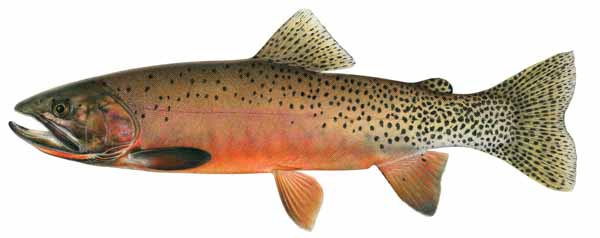
Yellowstone Cutthroat Trout
Oncorhynchus clarkii bouvieri
While the Yellowstone cutthroat trout evolved on the Pacific side of the Continental Divide, researchers think the species naturally entered the Atlantic drainage, possibly via Two Ocean Pass just north of Jackson Hole. The Yellowstone cutthroat’s native range encompasses a wide swath of territory centered on Yellowstone National Park that includes Montana, Idaho, Wyoming and a small part of northern Utah. Today the fish is found primarily in Yellowstone Lake, the Yellowstone River and its tributaries, the Snake River and the Falls River.
Overfishing, hybridization, whirling disease and habitat loss all pose threats to the Yellowstone cutthroat trout. In the park, genetically pure populations exist in and around Yellowstone Lake and the Yellowstone River, with known or suspected hybridized populations in the northern and western portions of the park. Irrigation dewatering has reduced spawning habitat in portions of its range. The fish is widely used for stocking mountain lakes on the east slope of the Rocky Mountains.
As with other cutthroats, the Yellowstone cutthroat has red slashes on the lower jaw. It is brown, yellow or silver on its back with medium to large black spots concentrated near its tail. The subspecies can grow as large as 15 pounds under certain conditions and range from six to 26 inches in length.
Yellowstone cutthroat require cold, clear water in streams or lakes. They rely heavily on aquatic insects such as mayflies, stoneflies and caddisflies, but also eat smaller fish, fish eggs, small mammals and frogs.
